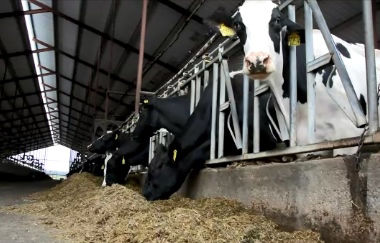Dairy producers from Texas, New Mexico, Kansas and Colorado gathered in Amarillo, Texas, March 6 and 7. The 2018 High Plains Dairy Conference kicked off with an in-depth look at the world dairy outlook.
Aga Perry, dairy analyst with Rabo AgriFinance, updated producers on the world dairy outlook. Overall, she said, global demand for milk and dairy products will remain strong and that should be good news for the market to improve by the end of 2018. But, between now and then, there will be some struggles for dairy, especially with the big dairy producing countries increasing production.
“Whenever we have more milk on the market than the market is willing to absorb we see declining prices,” Perry said. “We saw that in the second half of 2017 and we expect that to continue.” The European Union has recovered from its boom/bust trend and production has increased and is growing 2.1 percent year on year.
“If the EU in the next quarter grows by 6 percent it’s like the U.S. market growing by 9 percent,” she said. “It’s big growth and that means a lot more is going into the global market.”
The United States continues to increase its production capabilities, putting more pounds of milk on the market each year, which depresses prices, she said. No longer are the traditional states of Wisconsin, California, Pennsylvania or New York driving that production train.
“The states contributing to production are now Texas, Colorado and Kansas,” she said. “This is where the new efficiencies come from, right here.” In Colorado production grew 10.4 percent, while Texas had 5.8 percent growth, New Mexico 5 percent growth and Kansas 3.4 percent growth year on year.
This also means the U.S. herd is growing, with 54,000 cows added in Texas, New Mexico, Arizona and Colorado alone, and there’s not stopping anytime soon, she said. Those additional cows will need affordable feed and if the drought continues across the Plains, dairy producers should expect the cost of feed to trend upward next year.
In 2017, the story was butter, Perry said. Butter premiums made a lot of the production work last year, she said. The U.S., on a global scale, makes a smaller chunk of the butter production, but the country is one of the largest consumers of butter.
“Compared to five years ago, we ate more butter than margarine,” she said. “I’m happy to see that and cheese has a similar story.” Americans are eating more fancy cheeses and protein milkshakes and making the switch back to dairy from plant-based milks, driving U.S. consumption.
“We also eat more cheese going out to eat than staying at home and eating,” she said. “Cheese was the main growing category while fluid remained in decline.” Almost 36 pounds of cheese per capita consumption and growing, she added.
Nonfat Dry Milk Powder is a critical export opportunity for U.S. dairy producers, which is one more reason for building relationships with trading partners, she added.
“Over half of our exports of NFDM are to NAFTA countries and the majority of that is to Mexico,” Perry said. “We are pretty much their only source of NFDM, but the rhetoric is changing that. The risk of tariffs, a changing trade environment and pulling out of TPP means Mexico is rethinking its strategy of buying from the U.S. and diversifying.” There was a large spike in Mexico’s imports of NFDM from the U.S. just before the 2016 election, but we’ve gone from a 98 percent market share to less than 70 percent in a little over a year, Perry added.
“They’re allowing more exporters to come into their market,” she said. “They’re bringing in more from Spain and South America. Unfortunately with a trade situation like this, once that door is opened, it’s hard to close it. Even if NAFTA works out, there’s a good chance they’ll stay diversified.” With steel and aluminum tariffs in place, there’s a potential for retaliation against U.S. dairy, she added, especially since U.S. Speaker of the House Paul Ryan is from Wisconsin.
China is one of the few world markets still maintaining its import pace, even though the country is moving toward self-sufficiency, Perry said. Saudi Arabia and North Africa are also returning to importing dairy, with oil prices helping build that demand. Dairies can expect more demand from Southeast Asia and slow growth in demand from China, which may pick up in the second half of 2018. Latin American demand seems to be declining because of countries coming out of recessions. Most of the world is importing less dairy products than previous years. That means world stocks are growing.
“Rising global milk production means higher stocks and some of these importers will slow down or diversify to see if they can get better prices,” Perry said. Dairymen should really watch the record stocks of American cheese, butter and NFDM on hand. The EU has accumulated stocks, and if they release the 3,075 MMT of skim milk powder they have, it could be a big disruptor to the market, she said. If New Zealand continues into a drought, that could affect the global supply and price as well.
“A growing supply and large stocks will drive prices below breakevens for producers globally in 2018,” she said. “But producers will begin to respond to lower prices by the second half of 2018 and that production growth should slow down.” Expect global demand to grow and help the market improve by the end of the year, she added.
Jennifer M. Latzke can be reached at 620-227-1807 or [email protected].




